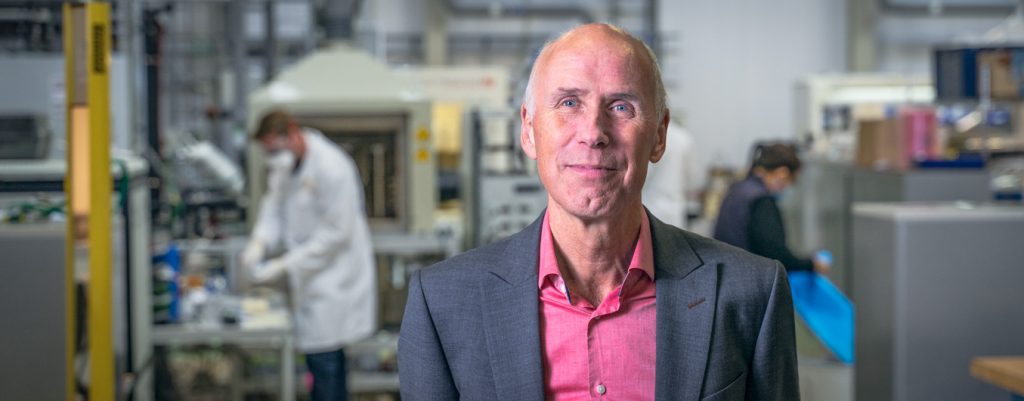Eindhoven Engine creates an impetus to accelerate innovation
Failure is the price of innovation
“You have to accept failure. If every project from your innovation department is a success, you are not bold enough in your endeavor to innovate. You are minimizing risks and playing it safe. Failure is inherent to innovation.”
We are sitting in a conference room on the High Tech Campus in Eindhoven and speaking with Jaap Lombaers, Director Knowledge Management and Partnerships at TNO. The room is situated in a modern, open-spaced building with large windows everywhere. Behind Jaap, there is a view into the laboratory. Researchers in white coats and safety goggles walk calmly and decisively from machine to machine under a maze of pipes reflecting the bright ceiling lights.

Applying new science and finding a market
A background in industrial design is not overly common for those working in a laboratory but when I mention this to Jaap, his eyes light up and he smiles. “I am inspired by all the things that go on inside this lab. I can tell the story of every machine in this room and why it is important to the progress of solar energy and of innovations in electronics. This lab is the merger of science and application.
You are right, industrial design is integrative rather than specialistic; during my studies, I learned to combine different fields of science and apply them to find new solutions. And this is what we do every day here at TNO.
What we try to accomplish at TNO isn’t just about science. The primary goal is working with large, multidisciplinary teams to create functional and economically-viable solutions. It’s a team effort in which we combine fundamental and applied science in order to create innovative solutions for the market.”
Combining strengths and creating a boost
“TNO is always on the lookout for partners who can amplify the abilities of our own organization. This is one of the reasons we supported the Eindhoven Engine initiative and even became a shareholder.
We appreciate that our partners, TU/e and Fontys, really are different from us and therefore complementary. Where we are trying to apply science, universities are pushing the frontiers of science itself and developing the new talents that industry and research organizations need.
These are bottom-up organizations with students, PhDs and scientists who are conducting new research. This creates a reservoir of young, keen minds which can provide a fresh, new perspective in ongoing projects. TU/e and Fontys are also connected to a vast network of companies, especially in the region of Eindhoven. Just like TNO, they frequently cooperate with large and well-known companies as well as smaller ones which do not have the luxury of extensive R&D departments.
In Eindhoven Engine, we combine these assets. We create multidisciplinary teams of research partners and students, unite them in one location in order to increase collaboration and give ongoing innovation projects a boost.
“If you want to make a leap
in your innovation project in just a couple of years,
Eindhoven Engine is the perfect platform.”
Not every innovation project is suited to Eindhoven Engine. If you want to do in-depth research, you just give scientists a large amount of time and resources to get to the bottom of it. But if you want to make a leap in your innovation project in just a couple of years, Eindhoven Engine is the perfect platform. At the moment, we have a team working on the development of a heat battery, for instance. This is an established program to which Eindhoven Engine adds an extra layer to accelerate the progress. In another project, we are developing solutions for flexible manufacturing (smartly combining the skills of operators with those of robots) alongside Fontys and multiple companies in a field lab on the Brainport Industries Campus (BIC).”
We just started
This kind of coordinated, multidisciplinary and systematic way of doing research is built into the genes of TNO. “We have gained considerable experience over the years in cooperating with different partners and consortia. This experience is what we can add to Eindhoven Engine. But don’t forget, Eindhoven Engine just got started last year. The paint had just dried in the Eindhoven Engine building when the corona pandemic engulfed the world. So, we have to give it some time to see what works well and what has to be improved.
There are still things we have to figure out. How to make smart use of co-location? I would recommend that the teams be situated at the best location given the nature of their projects. I would say that a team working on solar panels, for instance, should situate itself here at Solliance. In this building, we have a whole laboratory equipped to do research on thin-film solar cells. For those teams not permanently located at the Eindhoven Engine co-location, this location could be used as a clubhouse of sorts: a place to visit regularly and where cross-pollination between the different teams involving multiple organizations can occur. I am convinced that we can learn a lot from each other.”

